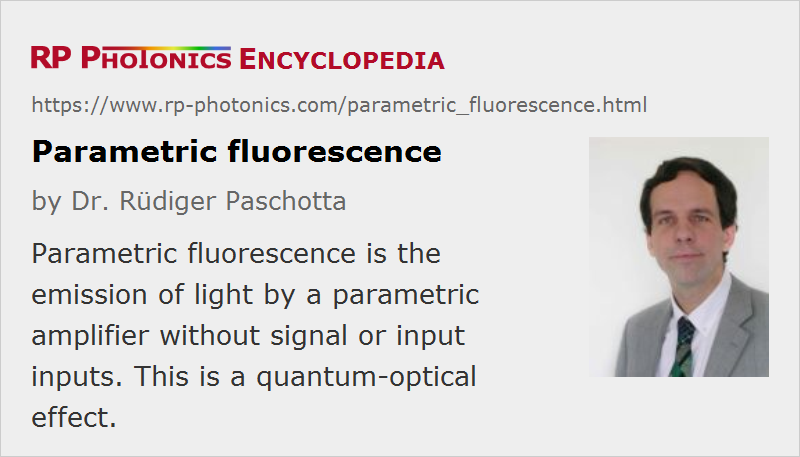Parametric Fluorescence
Definition: emission of light by a parametric amplifier without signal or input inputs
German: parametrische Fluoreszenz
Categories: nonlinear optics, quantum optics
How to cite the article; suggest additional literature
Author: Dr. Rüdiger Paschotta
An optical parametric amplifier emits some light even if there is no signal and idler input. This phenomenon is called parametric fluorescence. It is a quantum effect. In a semiclassical model, it can be attributed to vacuum fluctuations (vacuum noise) of the optical field which enters the open input port(s) of the device. In the case of a non-degenerate parametric amplifier, vacuum noise in the signal and idler ports have similar effects.
Parametric fluorescence is similar to the spontaneous emission in a laser amplifier, but occurs essentially only in directions where phase matching occurs. Therefore, it normally carries only a small optical power. There may, however, also be some off-axis parametric fluorescence which is non-collinearly phase-matched. The center wavelength will then depend on the propagation direction.
Parametric fluorescence can be useful for the alignment of a non-collinear parametric amplifier, since it shows the direction where phase matching and thus the maximum parametric gain occurs.
Questions and Comments from Users
Here you can submit questions and comments. As far as they get accepted by the author, they will appear above this paragraph together with the author’s answer. The author will decide on acceptance based on certain criteria. Essentially, the issue must be of sufficiently broad interest.
Please do not enter personal data here; we would otherwise delete it soon. (See also our privacy declaration.) If you wish to receive personal feedback or consultancy from the author, please contact him e.g. via e-mail.
By submitting the information, you give your consent to the potential publication of your inputs on our website according to our rules. (If you later retract your consent, we will delete those inputs.) As your inputs are first reviewed by the author, they may be published with some delay.
See also: optical parametric amplifiers, optical parametric oscillators, optical parametric generators, quantum noise
and other articles in the categories nonlinear optics, quantum optics
 |





If you like this page, please share the link with your friends and colleagues, e.g. via social media:
These sharing buttons are implemented in a privacy-friendly way!